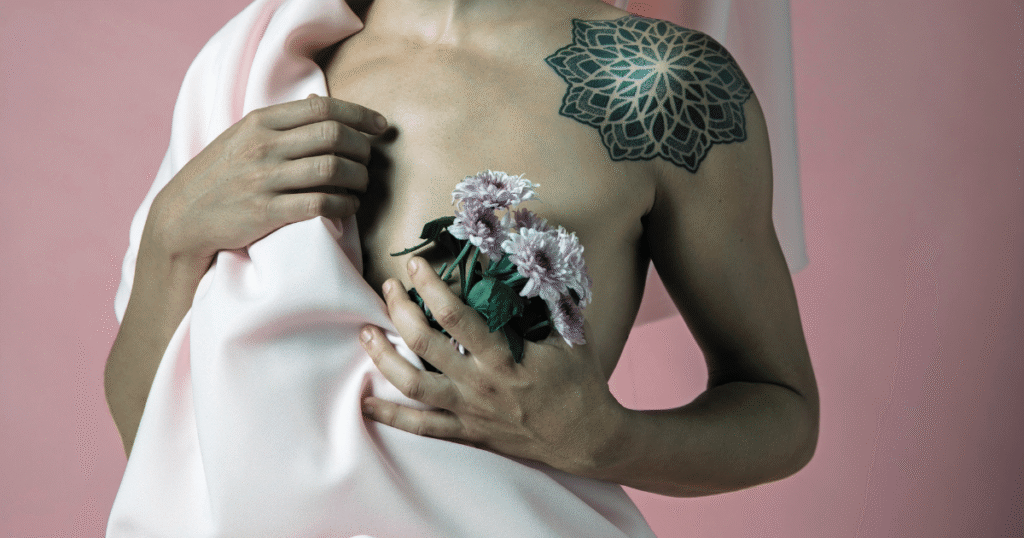Since 1985, October has been known as “Breast Cancer Awareness Month.”
Well, what does that mean exactly? We’re all pretty aware of the existence of breast cancer, after all. Many of us have known at least one person who has been diagnosed with breast cancer.
Meanwhile, what do we actually know about breast cancer?
Let’s start with the basics:
Breast cancer is a disease in which malignant (cancer) cells form in the tissues of the breast. [3]
Now, let’s learn a bit more!
1. Breast Cancer Statistics
- There are multiple types of breast cancer [3]
- Only 5 to 10 percent of breast cancers are tied to family history. [3]
- 1 in 8 cis-gendered women in the United States will be diagnosed with breast cancer in their lifetime. [3]
- In 2024, an estimated 310,720 cis-gendered women and 2,800 cis-gendered men will be diagnosed with invasive breast cancer. [3]
- Not all lumps are cancerous [3]
- Breast pain is common and usually not a sign of breast cancer. [3]

2. History of the Pink Ribbon
The pink ribbon has become the universal symbol of breast cancer, illustrating the cause, raising awareness, and bringing together people in solidarity. To symbolize hope and strength for those with breast cancer.
In the early 1990s, Charlotte Haley began making peach-colored ribbons to hand out to people. Each ribbon included a brief statement to advocate for breast cancer awareness and prevention. [6]
Charlotte’s mission started as a personal journey to advocate for her own family members who were battling breast cancer. It wasn’t long before various corporations and large media networks started contacting Charlotte to help her spread the word.
When Estée Lauder offered to market the ribbon nationwide in all their stores, Charlotte Haley declined. Haley was adamant about not working with corporations on her grassroots project. [7]
However, this didn’t stop Estée Lauder from wanting to advocate for breast cancer awareness. In the fall of 1992, Estée Lauder makeup counters handed out 1.5 million ribbons, each including a card describing the process to conduct a proper breast self-exam. – though this time, the ribbons were a bright pink color to avoid plagiarism. [7]
The rest is history; the pink ribbon is now a recognized symbol to represent breast cancer awareness.
3. All Genders Are at Risk for Breast Cancer
- One’s gender does not prevent or predict your chances of breast cancer. All people are born with breast cells and tissue. [3]
- Each year in the USA, around 3,000 cis-gendered men will be diagnosed with breast cancer. [3]
- Black cis-gendered men with breast cancer have been found to have a worse prognosis compared to white cis-gendered men with breast cancer. [3]
*** Anybody who notices lumps in their breast, nipple inversion, or any other breast change(s) should talk with their doctor. ***
4. Working the Night Shift Can Increase Your Risk of Breast Cancer
- A recent study found that individuals who consistently work night shifts may have increased chances of developing breast cancer. [4]
5. Black Cis-gendered Women Have Higher Death Rates from Breast Cancer
- The average age of Black cis-gendered women diagnosed with breast cancer is 60 years old, compared to an average age of 62 for white cis-gendered women. [3].
- Black cis-gendered women are 40% more likely to die of breast cancer compared to white cis-gendered women [3][5].
- Black women have the lowest 5-year relative breast cancer survival rate of any racial or ethnic group. [3].
6. One Breast is More Likely to Get Cancer than the Other
- A 2022 study discovered that breast cancer is more common on the left side than on the right side [1].
7. Wearing a Bra Does Not Cause Breast Cancer [2]
- There is no evidence that bra wearing, including bra cup size, the average number of hours/day worn, wearing a bra with an underwire, or age when first began regularly wearing a bra, was associated with risks of breast cancer.
In conclusion, understanding breast cancer isn’t just about knowing it exists; it’s like peeling an onion—lots of layers, maybe a few tears, and definitely some surprises.
From the pink ribbon’s unexpected rise to fame to the fact that not all lumps are villains, there’s much to learn! Remember, knowledge is power, and together, we can tackle breast cancer awareness with a smile—and maybe a pink tutu or two!
References
[1] Abdou, Y., Gupta, M., Asaoka, M. et al. Left-sided breast cancer is associated with aggressive biology and worse outcomes than right-sided breast cancer. Sci Rep 12, 13377 (2022). https://doi.org/10.1038/s41598-022-16749-4
[2] Chen, L., Malone, K. E., & Li, C. I. (2014). Bra wearing not associated with breast cancer risk: a population-based case-control study. Cancer Epidemiology, Biomarkers & Prevention, 23(10), 2181–2185. https://doi.org/10.1158/1055-9965.EPI-14-0414
[3] Giaquinto, A.N., Sung, H., Miller, K.D., Kramer, J.L., Newman, L.A., Minihan, A., Jemal, A. and Siegel, R.L. (2022), Breast Cancer Statistics, 2022. CA A Cancer J Clin, 72: 524-541. https://doi.org/10.3322/caac.21754
[4] Ijaz, S., Verbeek, J., Seidler, A., Lindbohm, M.-L., Ojajärvi, A., Orsini, N., Costa, G., & Neuvonen, K. (2013). Night-shift work and breast cancer — a systematic review and meta-analysis. Scandinavian Journal of Work, Environment & Health, 39(5), 431–447. http://www.jstor.org/stable/23558272
[5] Office of Public Health and Science, Health and Human Services Department. (2011, December 31). Breast Cancer: Black Women Have Higher Death Rates from Breast Cancer than Other Women. [Government]. Health and Human Services Department. https://www.govinfo.gov/app/details/GOVPUB-HE20-PURL-gpo40500
[6] https://www.nationalbreastcancer.org/breast-cancer-ribbon/
[7] https://www.bcaction.org/about-think-before-you-pink/resources/history-of-the-pink-ribbon/

